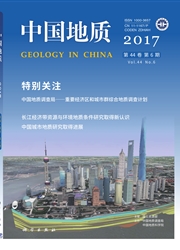

 中文摘要:
中文摘要:
位于西秦岭岷(县)—礼(县)成矿带西段的马坞金矿床,是近年发现的一个中型卡林型金矿床。矿体产出受NWW向断裂构造控制,其赋矿围岩为中泥盆统的千枚岩与灰岩。矿床流体包裹体研究表明,脉石矿物中主要发育CO2-H2O型和H2O溶液型包裹体;均一温度为135~389℃,盐度为4.4%~15.9%,为中-低温、中-低盐度流体;流体成矿压力为34.6~219.8 MPa,成矿深度为1.3~8.1 km。流体包裹体气相成分以H2O、N2为主,其次为CO2、O2,并含有少量CH4、CO等还原性气体;液相成分中阳离子以Ca^2+、Na^+为主,阴离子以C^l-和SO4^2-占主导地位,成矿流体为N2-H2O-Ca^2+-Cl^-体系。氢氧同位素测试结果表明,成矿流体的δ^18O水为5.3‰~10.5‰,δD为-123‰~-93‰,成矿流体主要为热卤水。从流体性质及其演化来看,构造体制的转换使流体稳定体系发生改变与沸腾作用是造成金富集成矿的主要因素。
 英文摘要:
英文摘要:
Located in the western part of the Min-Li metallogenic belt within the West Qinling Mountains, the Mawu gold deposit is a medium Carlin-type disseminated gold deposit discovered in recent years. The orebody is controlled by the NW-trending faults and hosted in the Devonian phyllite and limestone. Two main types of fluid inclusions, i.e., CO2-H20 inclusions and aqueous fluid inclusions, are trapped in the gangue minerals. The homogenization temperatures range from 135℃ to 389 ℃, while the salinities range from 4.4% to 15.9%, indicating medium-low temperature and medium-low salinity. The trapping pressures are 34.6 MPa to 219.8 MPa. The gold mineralization occurred at the depths of 1.3 km to 8.1 kin. Fluid inclusion analyses show that the gas phase is mainly composed of H20 and N2, with minor CO2 and 02, while the liquid phase is mainly composed of Ca^2+, Na^+, Cl^- and SO4^2-. The ore- forming fluid belongs to the N2- H20- Ca^2+- Cl^- system. The hydrogen and oxygen isotopic compositions of fluid inclusions show that δ^18O_H2O values range from 5.3‰ to 10.5‰, while 6 D values range from -123‰ to -93‰. The ore-forming fluid came from the geothermal brine. An analysis of the fluid evolution shows that the variation of the stability of the fluid system caused by the structural transition and the boiling action played vital roles in the precipitation of gold.
 同期刊论文项目
同期刊论文项目
 同项目期刊论文
同项目期刊论文
 U–Pb zircon geochronology and geochemistry of Late Jurassic basalts inMaevatanana,Madagascar: implic
U–Pb zircon geochronology and geochemistry of Late Jurassic basalts inMaevatanana,Madagascar: implic LA-ICP-MS and EPMA studies on the Fe-S-As minerals from the Jinlongshan gold deposit,Qinling Orogen,
LA-ICP-MS and EPMA studies on the Fe-S-As minerals from the Jinlongshan gold deposit,Qinling Orogen, LA-ICP-MS trace element analysis of pyrite from the Chang’an gold deposit, Sanjiang region, China: I
LA-ICP-MS trace element analysis of pyrite from the Chang’an gold deposit, Sanjiang region, China: I Gold mineralization in Proterozoic black shales: Example from the Haoyaoerhudong gold deposit, north
Gold mineralization in Proterozoic black shales: Example from the Haoyaoerhudong gold deposit, north An assessment of selected heavy metal contamination in the surface sediments from theSouth China Sea
An assessment of selected heavy metal contamination in the surface sediments from theSouth China Sea Early Carboniferous adakitic rocks in the area of the Tuwu deposit, eastern Tianshan, NW China: Slab
Early Carboniferous adakitic rocks in the area of the Tuwu deposit, eastern Tianshan, NW China: Slab Geochronology, petrogenesis and tectonic implications of the Zhongchuan granitic pluton in the Weste
Geochronology, petrogenesis and tectonic implications of the Zhongchuan granitic pluton in the Weste Zircon U-Pb and molybdenite Re-Os geochronology, and whole-rock geochemistry of the Hashitu molybden
Zircon U-Pb and molybdenite Re-Os geochronology, and whole-rock geochemistry of the Hashitu molybden Geological characteristics and ore-forming process of the gold deposits in the western Qinling regio
Geological characteristics and ore-forming process of the gold deposits in the western Qinling regio SHRIMP zircon U-Pb geochronology, geochemistry and H-O-Si-S-Pb isotope systematics of the Kanggur go
SHRIMP zircon U-Pb geochronology, geochemistry and H-O-Si-S-Pb isotope systematics of the Kanggur go Geology, C–H–O–S–Pb isotope systematics and geochronology of the Yindongpo gold deposit, Tongbai Mou
Geology, C–H–O–S–Pb isotope systematics and geochronology of the Yindongpo gold deposit, Tongbai Mou Source and evolution of fluids in the Shihu gold deposit, Taihang Mountains, China: evidence from mi
Source and evolution of fluids in the Shihu gold deposit, Taihang Mountains, China: evidence from mi Geochemistry, petrogenesis and tectonic implications of the granitic plutons at the Liziyuan orogeni
Geochemistry, petrogenesis and tectonic implications of the granitic plutons at the Liziyuan orogeni Fluorescence studies on local density change in supercritical CO2 mixtures using the order parameter
Fluorescence studies on local density change in supercritical CO2 mixtures using the order parameter Origin of a barite-sulfide ore deposit in theMykonosintrusion, cyclades: Trace element, isotopic, fl
Origin of a barite-sulfide ore deposit in theMykonosintrusion, cyclades: Trace element, isotopic, fl One-step synthesis of bentonite-supported nanoscale Fe/Ni bimetals for rapid degradation of methyl o
One-step synthesis of bentonite-supported nanoscale Fe/Ni bimetals for rapid degradation of methyl o Geochemical characteristics of rare earth elements and their implications for the Huachanggou gold d
Geochemical characteristics of rare earth elements and their implications for the Huachanggou gold d Zircon U-Pb ages and geochemistry of the Wenquan Mo-bearing granitioids in WesternQinling,China: Con
Zircon U-Pb ages and geochemistry of the Wenquan Mo-bearing granitioids in WesternQinling,China: Con Discovery and significance of Cu–Zn intermetallic compounds in the Jingxi gold deposit, westernTians
Discovery and significance of Cu–Zn intermetallic compounds in the Jingxi gold deposit, westernTians Fluid inclusions from the Jinchang Cu–Au deposit,Heilongjiang Province,NEChina: Genetic style and ma
Fluid inclusions from the Jinchang Cu–Au deposit,Heilongjiang Province,NEChina: Genetic style and ma 期刊信息
期刊信息
